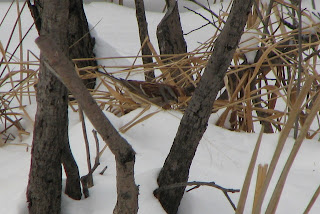The end of the year is a natural time for retrospection, with introspection not too far behind, and an event that occurred this week has been occupying my thoughts on several different levels.
But first things first. This actually started with me saying something I've never said before: "I'm going to meet up with a couple folks I met on the Internet."
Of course, you hear that in all kinds of parents-worst-nightmare scenarios, but I never thought I'd play the naive teenager off to rendezvous with some creepy old guy. Then it gets better: instead of meeting up in some well-attended public place, I gave out directions to my front door. And when they showed up, off we drove to rural, state-owned land where we only ran into one other person all morning.
 One of the species that influenced my decision to "connect"
One of the species that influenced my decision to "connect"
via the Internet. And well worth it, in many ways.Creepy? Not at all. The folks I met up with were Mike from
10,000 Birds and Seth from
Cup O' Books, the goal was to chase some winter finches near Ithaca. The very active Cayuga Lake Basin birding community has been scouring Summerhill for weeks, as it sports wonderful habitat to attract some of the most desirable winter birds:
Pine and
Evening Grosbeaks,
Red and
White-winged Crossbills,
Common Redpolls,
Northern Shrikes,
Rough-legged Hawks, and, although relatively common,
Red-breasted Nuthatches and
Purple Finches.
 Redpolls on a wire: if only all the sought-after species were so easy!
Redpolls on a wire: if only all the sought-after species were so easy!We had a mixed day, much like the weather. We arrived with the clouds in a quandary about whether to release snow or rain on us, which was resolved by dumping both at a fairly even rate. Immediately after stepping out of the car we heard
chickadees and a single
RB Nuthatch calling, and that would be it for our entire (very slippery) hike. Happily, a bird feeder just up the road came through with dozens of
Evening Grosbeaks, all easily viewable and photographable from inside the car.
 Only a few of the flock of Evening Grosbeaks frequenting
Only a few of the flock of Evening Grosbeaks frequenting
the feeders (alliteration unintended, but worth saving).Farther along the
redpolls made their appearance, and with the exception of three
Ruffed Grouse that sprinted across the road ahead of our car, that'd be it for notable species.
 Waiting for clearance to approach a feeding station, Common Redpolls gather atop a cluster of spruces.
Waiting for clearance to approach a feeding station, Common Redpolls gather atop a cluster of spruces.After not hearing any flyover
finches and not seeing any perched
shrikes or
Rough-leggeds, we made our way back to Ithaca, ate lunch while sitting in the staff lounge at the
Cornell Lab of Ornithology, and walked a quick loop around Sapsucker Woods Pond (wishing for the local
shrike to make a quick appearance).
So, at the end of the day, the birds were mixed, but the trip was awesome: I rediscovered the beauty of connecting with like-minded people again. This is what I've been dwelling on, what's been the impetus for some reminiscing, some longing, and some catharsis: the social aspect of birding. This is a hobby (obsession?) that works perfectly on the solitary end of the spectrum, but just as well on the other end, and it's that side I've been missing.
Once upon a time, I was young, unattached birder with a great group of birding buddies. We birded a lot, chasing vagrants, plotting big days, scouring hot spots near and far. Naturally, we interacted, communicated, shared, and learned.
 Jay Withgott, perhaps the most influential person in my
Jay Withgott, perhaps the most influential person in my
birding career. We've now birded in at least four states
together, though we keep missing each other when scouting
New Jersey for the World Series of Birding. One day . . . .But I'm not there, at that point of life, anymore, and most of my birding these days is solo. I work with some of the most amazing birders in the country, but I live far enough out of "the Basin" that I'm not regularly available to bird with them.
Most of my birding is around the house, for a simple reason: my love of spending time with my 3.75-year-old outweighs the attraction of vagrants, lists, and even the just-a-bit-too-far hotspots in our area. Though my daughter is almost ready to make some birding trips, she's not quite there.
So, a gratifying shout out to Mike and Seth for instigating the trip, and thanking them for bringing back some wonderful memories of birding trips past, and hopefully, future. Presently, however, I'm happy with what I get.
For another review of the trip, please read Mike's excellent account of our exploration
here.
 A possessed Mourning Dove - you can tell by the pale,
A possessed Mourning Dove - you can tell by the pale, Black-capped Chickadee strikes a pose. It's better
Black-capped Chickadee strikes a pose. It's better Tufted Titmouse finds the the last sunflower, and
Tufted Titmouse finds the the last sunflower, and White-breasted Nuthatch left with nothing but
White-breasted Nuthatch left with nothing but Could that be a Hoary? No, a Common Redpoll.
Could that be a Hoary? No, a Common Redpoll. 

































